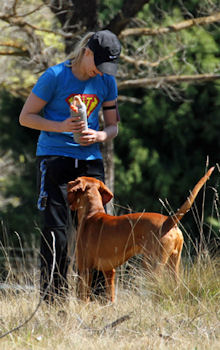How to Motivate your Dog with
Positive Training
by Joe Law
20 January 2013

To
train your retriever you must understand what motivates him. If your
dog, knowing that you have food in your possession, approaches you with
beseeching eyes it will be obvious what he is seeking. You will also
know that he is trying to devise a way to convince you to part with
that food in his favour. At that moment you will be in a position to do
some collective bargaining and all you will need to do is devise a way
of communicating your part of the deal. In this situation food is used
as a primary motivator for getting the response you want. In retrieving
breeds that have a strong prey drive, the opportunity to retrieve or
even to take hold of some favourite object can be used as a primary
reinforcer for achieving the response you desire.
Secondary
reinforcers (also referred to as conditioned reinforcers) are those
things that a dog learns to recognise as valuable because of their
association with primary reinforcers. When a dog hears the sound of a
dish being scraped or of a bag being rattled and then sprints towards
that sound it is because he has learnt the sounds are associated with
food. If your dog will come running to those sounds it should be
possible to train your dog to respond to any distinct sound as long as
it perceives there is some reward for doing so. By assessing your dog’s
personality and social inclinations secondary reinforcers such as
praise, affection or simply the joy of being with you can all be used
as motivators.
An important technique in the art of positive training is sometimes
referred to as bridging.
The main purpose of the bridge is to mark
a specific behaviour letting a dog know that a reward is coming. In
conjunction with a consistent and repetitious course of training, a “click”
or “one
syllable word” will become a conditioned reinforcer in its
own right. That one syllable bridge word ( such as Yes!
or Good!
) delivered in an upbeat fashion is the lynchpin in positive retriever
training. This enables the trainer to mark behaviours at a great
distance and then administer a reward once the dog has returned to you.
It is only by building up the power of secondary reinforcers that you
will be able to teach a dog to perform consistently at a distance
without resorting to force methods.
Photo by Lara Sedgman
This is an edited
version of an article that first appeared in the May 2013 issue of Dogs
NSW magazine.
©
This
page is provided by Working Gundog Club Inc.
(Affiliated with Dogs NSW)

